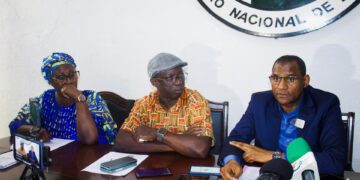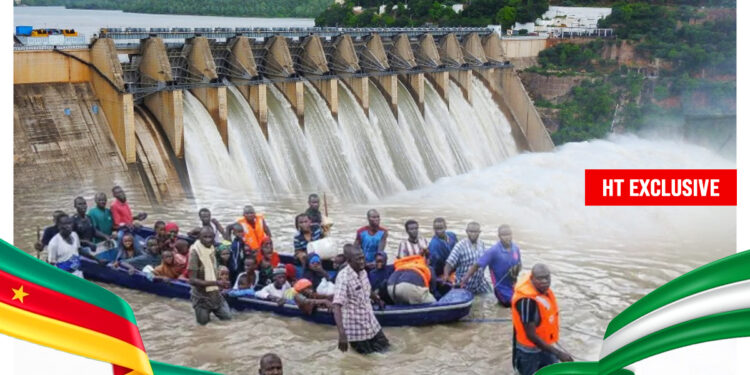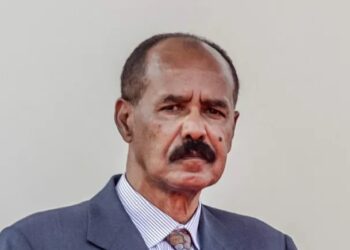By Emmanuel Nduka
On Monday, September 16, 2024, President Bola Tinubu visited Maiduguri, the submerged capital of Borno State in northeastern Nigeria. “May Allah help us stop the tragedy; the situation that we find ourselves in, the environmental problem and climate change,” the News Agency of Nigeria quoted President Tinubu as saying during his visit to the state shortly after he returned from an overseas trip.
Before the opening of Cameroon’s Lagdo Dam earlier in the week, parts of Borno had been submerged by flood after the collapse of a nearby dam which had been neglected for years. Heritage Times HT reports that cracks had begun to appear on the walls of the ‘Alau Dam’ which reportedly has the capacity to retain up to 112 million cubic litres of water, before it became overwhelmed and finally caved in, according to sources.
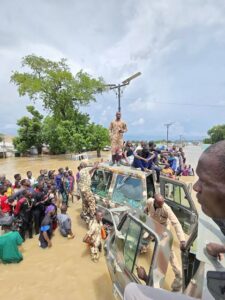
Citing negligence and misappropriation, experts have countered the several excuses of government. Documents sighted by Heritage Times HT showed that Nigeria’s Ministry of Water Resources had earmarked over N432,000 for the rehabilitation of the Alau Dam between 2020 and 2024. Neglected structural defects discovered nine years ago on the nearly 40-year-old dam was reportedly responsible for the devastating flood in Borno.
According to the Federation Account Allocation Committee (FAAC) data published by the National Bureau of Statistics (NBS), the Borno State Government had also received separate funding for flood related solutions to the time of N816.34 million from the Ecological Fund Office between January and June 2024.
Admitting Negligence
Borno State Governor, Professor Babagana Zulum admitted in a recent interview with local television CHANNELS that neglect of the dam over the years had been a major challenge, but that efforts were already being made to remedy the situation.
“Rescue mission is ongoing, but quite a number of people were rescued. So, this is the situation we are in. We had similar disaster 30 years ago, although the extent is not up to this one,” he said.
“But I believe the dam requires reconstruction. Now that we receive increase volume of water into the dam, coupled with climate change, there is the need to increase the carrying capacity of the dam,” he admitted.
State Officials had on Wednesday said the severe flooding in the northeastern city claimed at least 30 lives and forced 400,000 people from their homes. Water-borne diseases also looms in the aftermath, even as dangerous reptiles were reportedly displaced from their aquatic abode onto residential premises.

Lagdo Dam Disaster on the Verge
Completed in 1982, the Lagdo Dam rests on the Benue River in northern Cameroon, in the Niger Basin. The now troublesome facility was built by the Chinese to provide portable water, irrigation for farmlands and hydroelectric power generation in Garoua and the northern provinces of Cameroon. The facility has been a pivotal infrastructure project that influences surrounding local economies and the intricate relationship between Nigeria and Cameroon, spanning over four decades. The dam’s impact on water management, energy production, and regional diplomacy reflects both collaboration and tension between both countries.
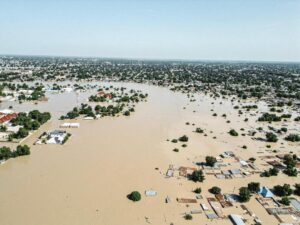
‘Horror years’
While the impact of the Lagdo Dam on the Cameroon side is mostly beneficial and enjoyed, the story is the opposite across the larger Nigerian domain. The “controlled release” of excess water from the dam which flows into the River Benue and cascades through the River Niger often translates into loss of lives, properties and displacements from ancestral lands. This has surged on through 12 different administrations in Nigeria, from 1982 to 2024, wreaking annual havoc across 11 states.
According to experts, Nigeria’s failure to build a dam of its own to backstop Cameroon’s Lagdo Dam has only worsened the horror. When Cameroon built the Lagdo Dam in 1982, the Nigerian government agreed to build a twin dam – the ‘Dasin Hausa Dam’ in Adamawa State to contain the overflow of Lagdo. But it has never been built by any government till date. Is the Tinubu administration going to handle it differently? The answer is not a hundred percent in the affirmative. But his administration has ‘promised’ to build fiver buffer dams to mitigate the flooding. Few days ago on September 17, 2024, Umar Mohammed, Director-General of the Nigeria Hydrological Services Agency (NIHSA) could not do more than just an announcement to Nigerians to “stay alert” and “possibly evacuate their homes” as this year’s Lagdo horror beckons. Adamawa, Taraba, Benue, Nasarawa, Kogi, Edo, Delta, Anambra, Bayelsa, Cross River and Rivers states were flagged as Red zones.
“The Nigeria Hydrolagical Services Agency (NIHSA) wishes to inform the general public that the Authority of Lagdo dam in Cameroon have informed the Agency that the dam management will begin regulated water releases at the rate of 100m/s (8.640,000m’/day) on 17th September, 2024. The water release is expected to increase gradually to 1000m/s in the next 7 days depending on the inflow from the upstream Garoua River which is the main feeder into the reservoir and a major contributor to the Benue River,” the NIHSA advised.
In 2022 alone, the disaster claimed over 600 lives and displaced farmlands. This loss was estimated at around $9billion, according to the Nigerian Bureau of Statistics (NBS).
Past efforts
Over the years, Nigeria and Cameroon have engaged in negotiations to manage water resources collaboratively. Agreements like the 1994 framework for managing the Benue River Basin reflects attempts to address mutual concerns. Since the overflow of the Lagdo Dam into Nigeria in 2012, Nigeria has incurred billions of dollars in losses.
Between 2010 and 2015, former President Goodluck Jonathan implemented the National Flood Emergency Response Plan, a comprehensive disaster management strategy to address flooding. Before then, his predecessor, Umar Musa Yar’Adua creatively enhanced meteorological services to better forecast floods. During their time, former leaders Olusegun Obasanjo and Ibrahim Babangida strengthened diplomatic discussions with Cameroon to ensure timely communication about Lagdo Dam’s operations.














